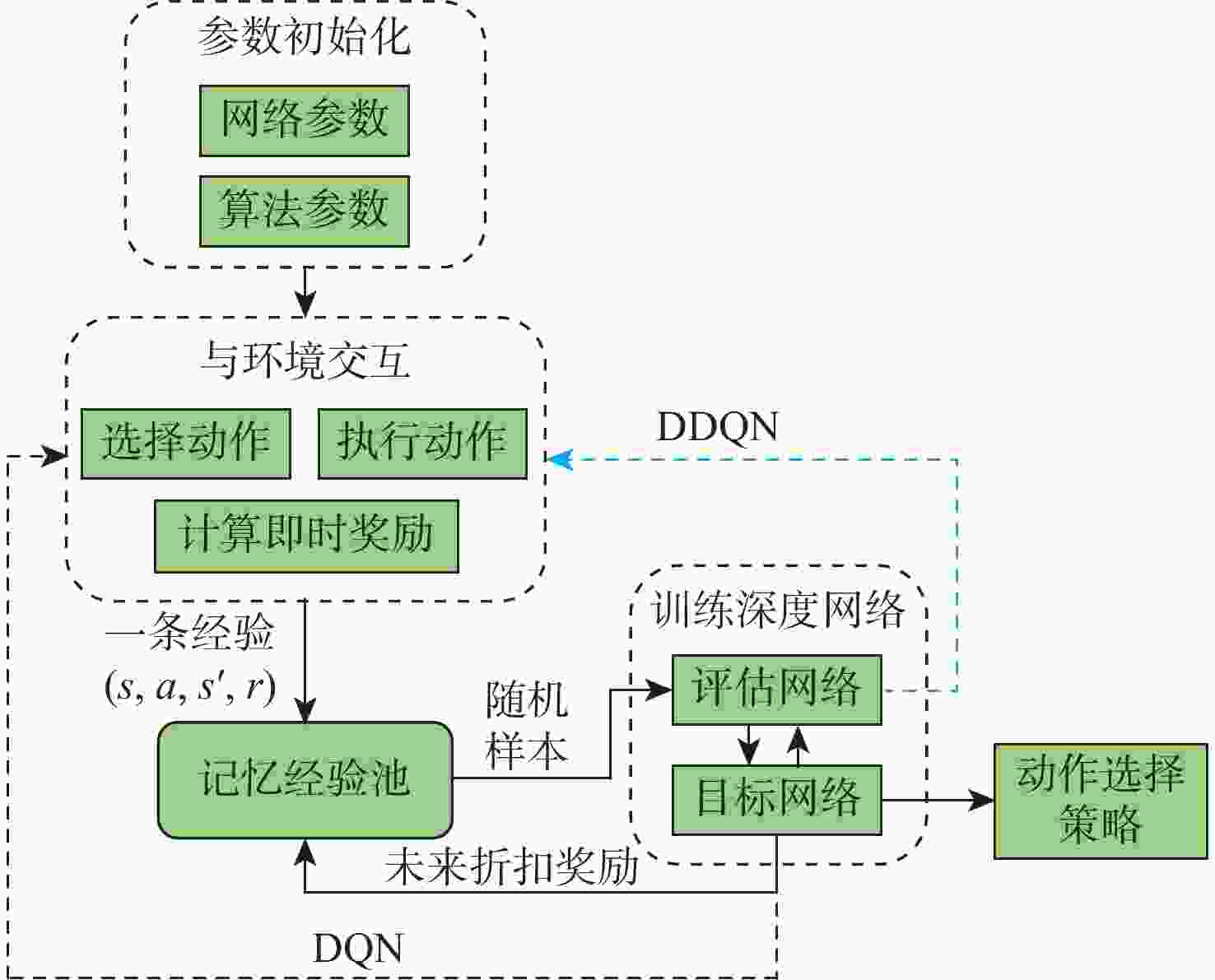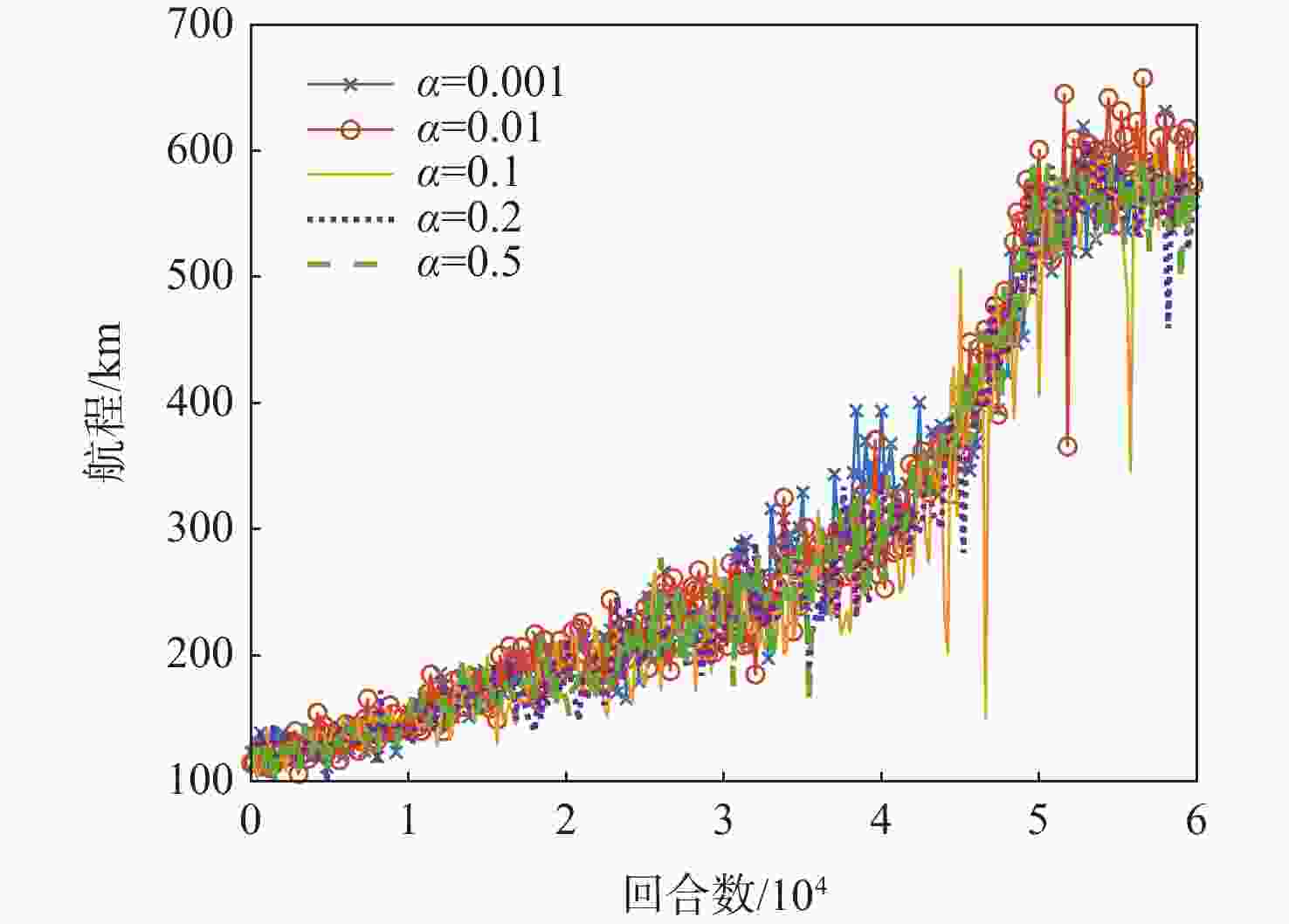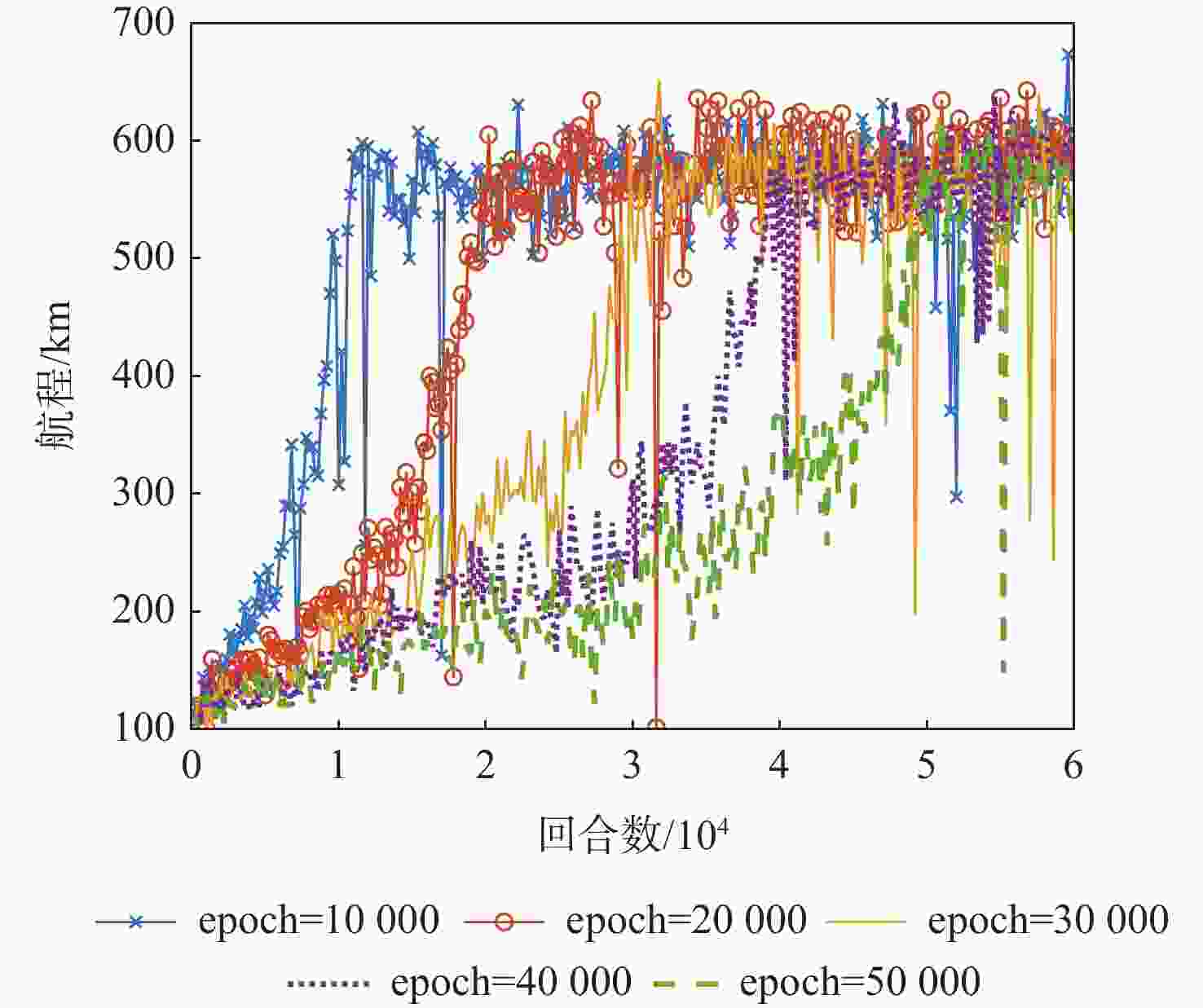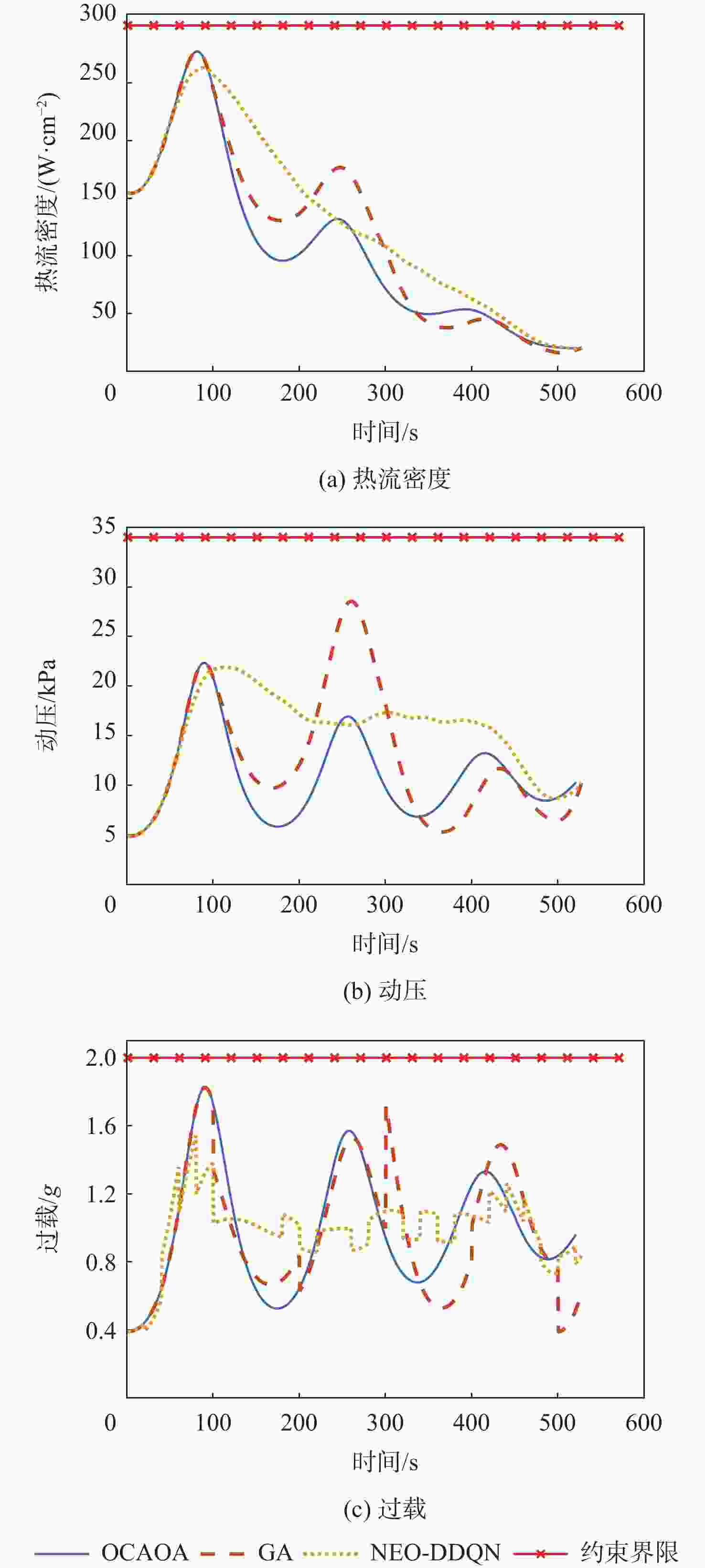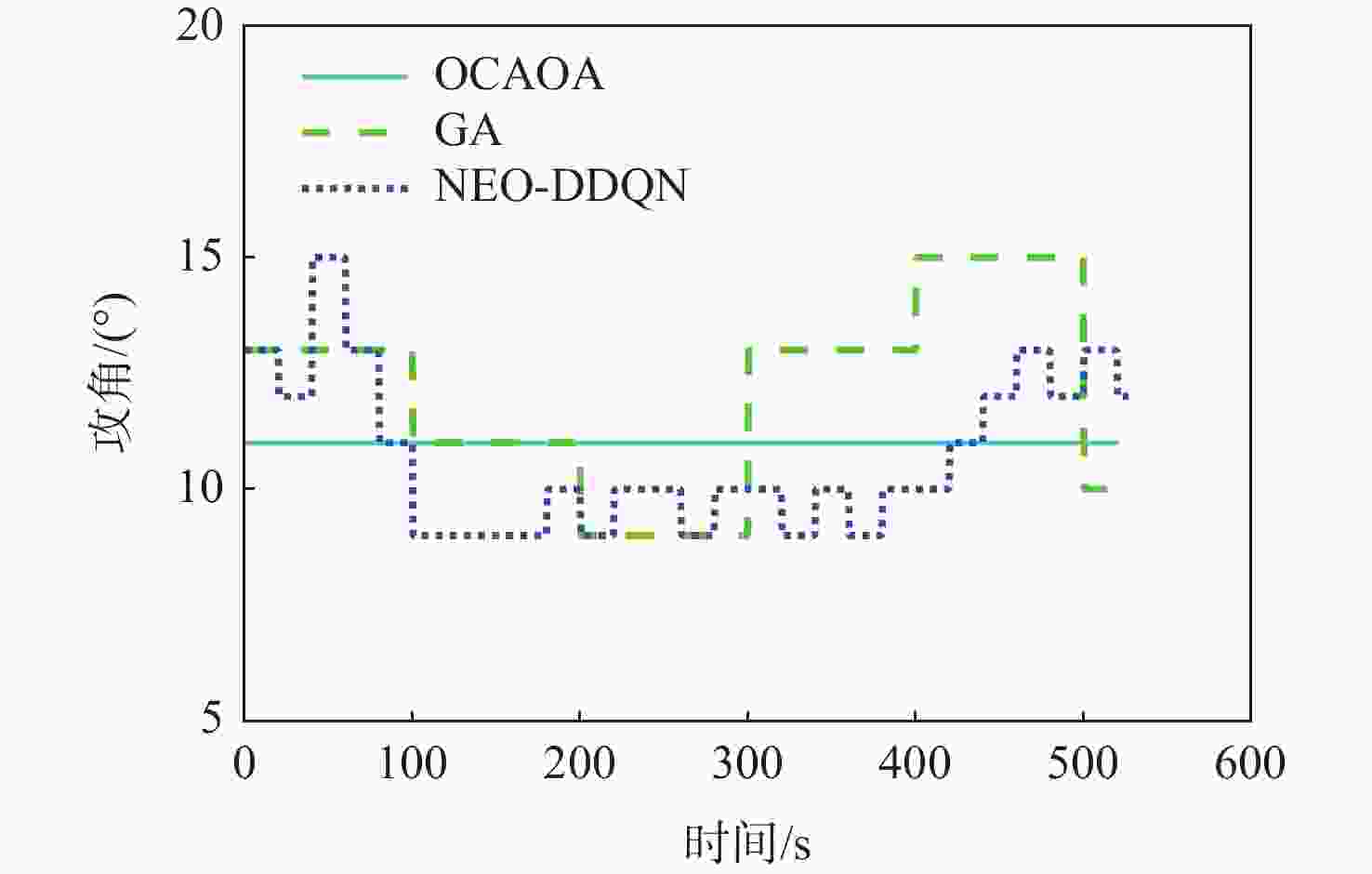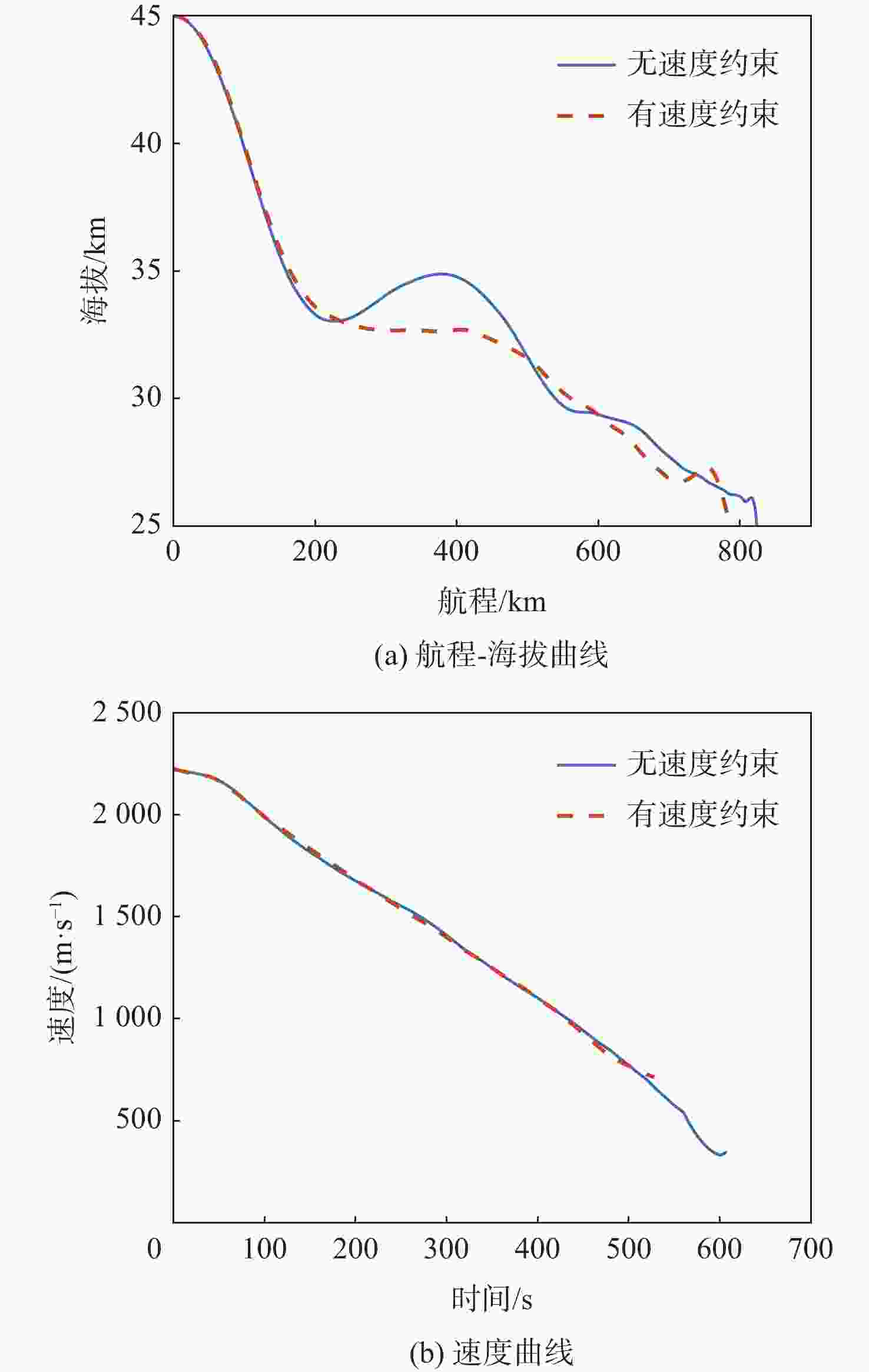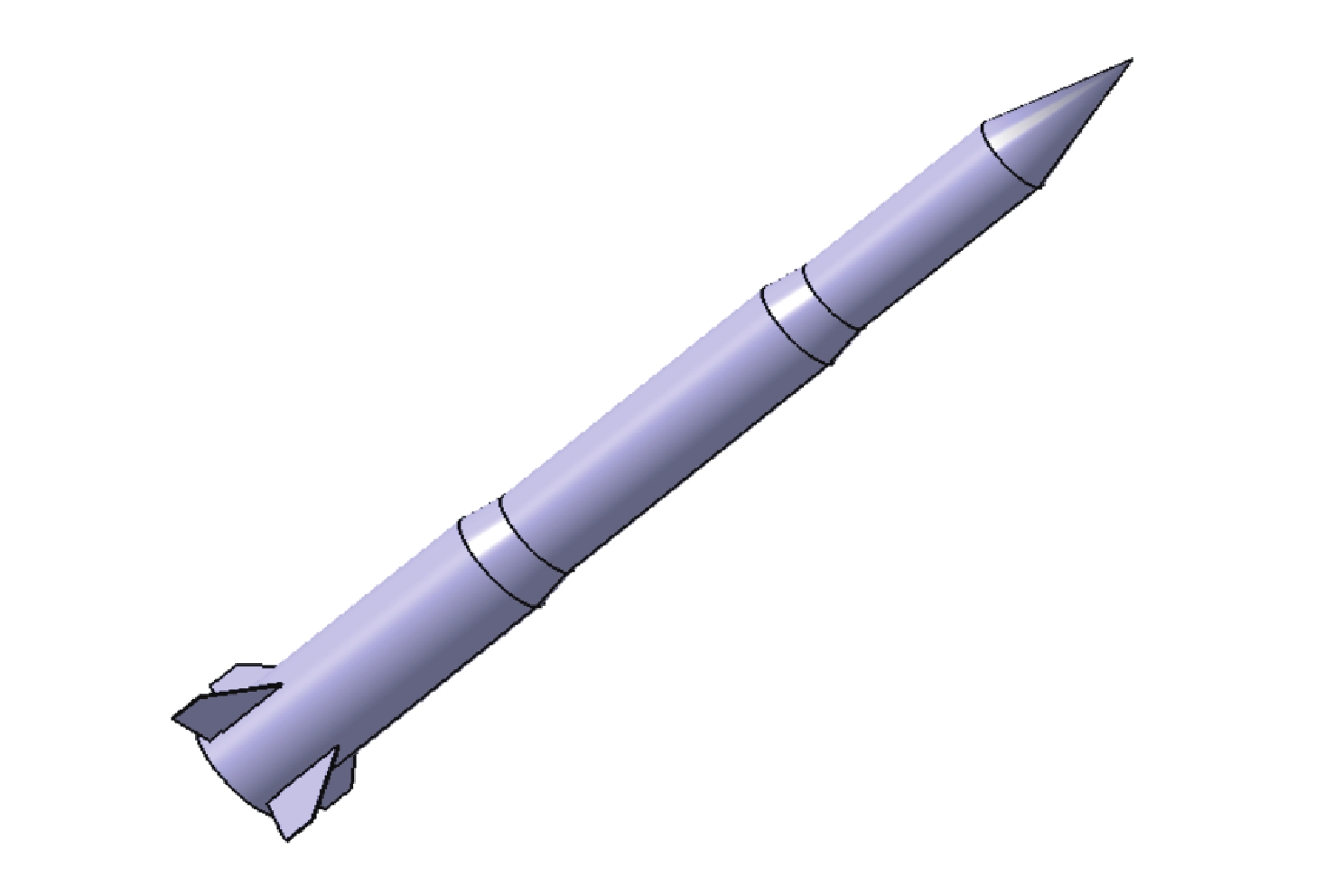Trajectory optimization algorithm of skipping missile based on deep reinforcement learning
-
摘要:
导弹的跳跃飞行过程可建模为时变非线性微分方程组,该方程组难以得到解析解,给导弹的轨迹优化带来很大的困难。针对该问题,提出一种基于双深度Q网络的带网络优选(NEO)策略的深度强化学习 (NEO-DDQN)算法,所提算法以跳跃导弹航程最大化为优化目标,在热流密度、动压、过载及末速度等约束下,求解跳跃导弹的轨迹优化问题。设计问题的动作空间、状态空间和奖励函数;确定算法关键参数学习率的取值及合适的贪心策略,并提出NEO策略,得到所提NEO-DDQN算法;开展与最优恒定攻角(OCAOA)方案、遗传算法(GA)的对比实验。结果表明:NEO策略有效提升了算法的求解稳定性且将航程提升了2.52%;与OCAOA方案、GA相比,所提算法使跳跃导弹航程分别提高了2.61%和1.33%;所提算法还避免了直接求解复杂非线性微分方程,为轨迹优化问题提供了一种新型的基于学习的算法。
Abstract:The skipping flight process of the skipping missile can be modeled as a set of time-varying nonlinear differential equations which cannot be solved analytically. Therefore, it brings great difficulties to optimize the trajectory optimization of the skipping missile. To solve this problem, a deep reinforcement learning trajectory optimization method based on double deep Q-network (DDQN) is proposed to maximize the range of the missile under certain constraints of heat flux, dynamic pressure, and overload. The procedure of this method is as follows. Firstly, the action space, state space, and reward function of the algorithm are designed. The appropriate greedy strategy is then determind, along with the learning rate, an important algorithmic parameter. Further, the network optimization (NEO) strategy is introduced and then the NEO-DDQN algorithm is proposed. Finally, comparison experiments with the optional constant angle of attack (OCAOA) scheme and genetic algorithm (GA) are designed. Results show that the network optimization strategy effectively improves the stability of the algorithm and increases the flight range by 2.52%. Compared with OCAOA scheme and GA, the NEO-DDQN method improves the range of skipping missiles by 2.61% and 1.33% respectively. In addition, the proposed method successfully avoids directly dealing with complex nonlinear differential equations and innovatively provides a learning-based method for the trajectory optimization of the missile.
-
Key words:
- missile /
- skipping flight /
- trajectory optimization /
- deep reinforcement learning /
- network optimization
-
表 1 导弹跳跃飞行仿真参数
Table 1. Simulation parameters of missile skipping flight
参数 数值 初始位置/m (0, 45000) 初速度大小/(m·s−1) 2224 初始速度倾角/(°) 0 质量/kg 574 特征面积/m2 0.203 高度约束/km 25~ 45 表 2 不同时间间隔对训练的影响
Table 2. Influence of different time intervals on training
分段时间间隔/s 航程/m 10 747878 20 776593 40 775804 50 768351 表 3 网络结构参数
Table 3. Parameters of network structure
层数 神经元个数 输入层 5 隐含层1 40 隐含层2 40 输出层 1 表 4 NEO-DDQN算法参数
Table 4. Parameters of NEO-DDQN algorithm
参数 数值 观察期回合数N1 500 训练期回合数N2 59500 训练频率N3 20 更新频率N4 200 折扣因子$ \gamma $ 0.95 批大小B 32 记忆池大小M 4000 表 5 5种学习率最终航程的收敛值
Table 5. Final range convergence values of 5 learning rates
学习率 收敛值/m 0.001 745654 0.01 781434 0.1 774864 0.2 743651 0.5 746867 表 6 5种贪心策略最终航程的收敛值
Table 6. Final range convergence values of 5 greedy strategies
epoch 收敛值/m 10000 771926 20000 778832 30000 771433 40000 764878 50000 776593 表 7 NEO策略对算法结果的影响
Table 7. Influence of NEO strategy on algorithm results
编号 $ \theta_{1} $/m $ \theta_{2} $/m $ \theta_{2} $−$ \theta_{1} $/m 1 767040 771830 4790 2 760609 774440 13831 3 767642 769734 2092 4 770645 771134 489 5 771587 784626 13039 6 702365 781316 78951 7 762389 785295 22906 8 764834 783575 18741 9 754677 777747 23070 10 755698 768921 13223 平均值 757748 776861 19113 表 8 GA的参数设置
Table 8. Parameters setting of genetic algorithm
参数 数值 时间间隔T/s 20 攻角/(°) 0~30(整数) 种群大小N5 10 交叉概率Pc 0.8 变异概率Pv 0.9 迭代次数I 100 表 9 GA的优化结果
Table 9. Optimization results of genetic algorithm
编号 航程 /m 1 741955 2 767656 3 752029 4 730913 5 721760 6 775017 7 764682 8 751243 9 744770 10 761691 表 10 3种算法的优化结果
Table 10. Optimization results of three algorithms
算法 航程
/m末速度/(m·s−1) 航程提升 /% OCAOA 765343 715 0.00 GA 775017 722 1.26 NEO-DDQN 785295 713 2.61 -
[1] 王在铎, 王惠, 丁楠, 等. 高超声速飞行器技术研究进展[J]. 科技导报, 2021, 39(11): 59-67. doi: 10.3981/j.issn.1000-7857.2021.11.007WANG Z D, WANG H, DING N, et al. Research on the development of hypersonic vehicle technology[J]. Science & Technology Review, 2021, 39(11): 59-67(in Chinese). doi: 10.3981/j.issn.1000-7857.2021.11.007 [2] 邵雷, 雷虎民, 赵锦. 临近空间高超声速飞行器轨迹预测方法研究进展[J]. 航空兵器, 2021, 28(2): 34-39. doi: 10.12132/ISSN.1673-5048.2020.0138SHAO L, LEI H M, ZHAO J. Research progress in trajectory prediction for near space hypersonic vehicle[J]. Aero Weaponry, 2021, 28(2): 34-39(in Chinese). doi: 10.12132/ISSN.1673-5048.2020.0138 [3] 陈小庆, 侯中喜, 刘建霞. 高超声速滑翔式飞行器再入轨迹多目标多约束优化[J]. 国防科技大学学报, 2009, 31(6): 77-83. doi: 10.3969/j.issn.1001-2486.2009.06.015CHEN X Q, HOU Z X, LIU J X. Multi-objective optimization of reentry trajectory for hypersonic glide vehicle with multi-constraints[J]. Journal of National University of Defense Technology, 2009, 31(6): 77-83(in Chinese). doi: 10.3969/j.issn.1001-2486.2009.06.015 [4] AN K, GUO Z Y, XU X P, et al. A framework of trajectory design and optimization for the hypersonic gliding vehicle[J]. Aerospace Science and Technology, 2020, 106: 106110. doi: 10.1016/j.ast.2020.106110 [5] 何烈堂, 柳军, 侯中喜, 等. 无动力跳跃式跨大气层飞行的可行性研究[J]. 弹箭与制导学报, 2008, 28(2): 155-157. doi: 10.3969/j.issn.1673-9728.2008.02.048HE L T, LIU J, HOU Z X, et al. Feasibility study of unpropulsive skipping trans-atmospheric flight[J]. Journal of Projectiles, Rockets, Missiles and Guidance, 2008, 28(2): 155-157(in Chinese). doi: 10.3969/j.issn.1673-9728.2008.02.048 [6] 国海峰, 黄长强, 丁达理, 等. 考虑随机干扰的高超声速滑翔飞行器轨迹优化[J]. 北京航空航天大学学报, 2014, 40(9): 1281-1290. doi: 10.13700/j.bh.1001-5965.2013.0755GUO H F, HUANG C Q, DING D L, et al. Trajectory optimization for hypersonic gliding vehicle considering stochastic disturbance[J]. Journal of Beijing University of Aeronautics and Astronautics, 2014, 40(9): 1281-1290(in Chinese). doi: 10.13700/j.bh.1001-5965.2013.0755 [7] GATH P F, WELL K H, MEHLEM K. Initial guess generation for rocket ascent trajectory optimization using indirect methods[J]. Journal of Spacecraft and Rockets, 2002, 39(4): 515-521. doi: 10.2514/2.3864 [8] BARRON R L, CHICK C M. Improved indirect method for air-vehicle trajectory optimization[J]. Journal of Guidance, Control, and Dynamics, 2006, 29(3): 643-652. doi: 10.2514/1.16228 [9] ROSA SENTINELLA M, CASALINO L. Genetic algorithm and indirect method coupling for low-thrust trajectory optimization[C]//42nd AIAA/ASME/SAE/ASEE Joint Propulsion Conference & Exhibit. Reston: AIAA, 2006: 4468. [10] 李瑜, 杨志红, 崔乃刚. 洲际助推-滑翔导弹全程突防弹道优化[J]. 固体火箭技术, 2010, 33(2): 125-130. doi: 10.3969/j.issn.1006-2793.2010.02.002LI Y, YANG Z H, CUI N G. Optimization of overall penetration trajectory for intercontinental boost-glide missile[J]. Journal of Solid Rocket Technology, 2010, 33(2): 125-130(in Chinese). doi: 10.3969/j.issn.1006-2793.2010.02.002 [11] 涂良辉, 袁建平, 岳晓奎, 等. 基于直接配点法的再入轨迹优化设计[J]. 西北工业大学学报, 2006, 24(5): 653-657. doi: 10.3969/j.issn.1000-2758.2006.05.026TU L H, YUAN J P, YUE X K, et al. Improving design of reentry vehicle trajectory optimization using direct collocation method[J]. Journal of Northwestern Polytechnical University, 2006, 24(5): 653-657(in Chinese). doi: 10.3969/j.issn.1000-2758.2006.05.026 [12] RAO A, CLARKE K. Performance optimization of a maneuvering re-entry vehicle using a Legendre pseudospectral method[C]//AIAA Atmospheric Flight Mechanics Conference and Exhibit. Reston: AIAA, 2002: 4885. [13] COTTRILL G C, HARMON F G. Hybrid Gauss pseudospectral and generalized polynomial chaos algorithm to solve stochastic optimal control problems[C]//AIAA Guidance, Navigation, and Control Conference. Reston: AIAA, 2011: 6572. [14] KUMAR G N, AHMED M S, SARKAR A K, et al. Reentry trajectory optimization using gradient free algorithms[J]. IFAC-Papers OnLine, 2018, 51(1): 650-655. doi: 10.1016/j.ifacol.2018.05.109 [15] CHAI R Q, SAVVARIS A, TSOURDOS A, et al. Solving multi-objective aeroassisted spacecraft trajectory optimization problems using extended NSGA-II[C]// AIAA SPACE and Astronautics Forum and Exposition. Reston: AIAA, 2017: 5193. [16] ZHAO J, ZHOU R. Particle swarm optimization applied to hypersonic reentry trajectories[J]. Chinese Journal of Aeronautics, 2015, 28(3): 822-831. doi: 10.1016/j.cja.2015.04.007 [17] SHAHZAD SANA K, HU W D. Hypersonic reentry trajectory planning by using hybrid fractional-order particle swarm optimization and gravitational search algorithm[J]. Chinese Journal of Aeronautics, 2021, 34(1): 50-67. doi: 10.1016/j.cja.2020.09.039 [18] SONG X, HAN D L, SUN J H, et al. A data-driven neural network approach to simulate pedestrian movement[J]. Physica A: Statistical Mechanics and its Applications, 2018, 509(11): 827-844. [19] 桑晨, 郭杰, 唐胜景, 等. 基于DDPG算法的变体飞行器自主变形决策[J]. 北京航空航天大学学报, 2022, 48(5): 910-919.SANG C, GUO J, TANG S J, et al. Autonomous deformation decision making of morphing aircraft based on DDPG algorithm[J]. Journal of Beijing University of Aeronautics and Astronautics, 2022, 48(5): 910-919(in Chinese). [20] 许轲, 吴凤鸽, 赵军锁. 基于深度强化学习的软件定义卫星姿态控制算法[J]. 北京航空航天大学学报, 2018, 44(12): 2651-2659. doi: 10.13700/j.bh.1001-5965.2018.0357XU K, WU F G, ZHAO J S. Software defined satellite attitude control algorithm based on deep reinforcement learning[J]. Journal of Beijing University of Aeronautics and Astronautics, 2018, 44(12): 2651-2659(in Chinese). doi: 10.13700/j.bh.1001-5965.2018.0357 [21] NI W J, WU D, MA X P. Energy-optimal flight strategy for solar-powered aircraft using reinforcement learning with discrete actions[J]. IEEE Access, 2021, 9: 95317-95334. doi: 10.1109/ACCESS.2021.3095224 [22] JIANG L, NAN Y, LI Z H. Realizing midcourse penetration with deep reinforcement learning[J]. IEEE Access, 2021, 9: 89812-89822. [23] GAO J S, SHI X M, CHENG Z T, et al. Reentry trajectory optimization based on deep reinforcement learning[C]//2019 Chinese Control and Decision Conference (CCDC). Piscataway: IEEE Press, 2019: 2588-2592. [24] MNIH V, KAVUKCUOGLU K, SILVER D, et al. Human-level control through deep reinforcement learning[J]. Nature, 2015, 518(7540): 529-533. doi: 10.1038/nature14236 [25] MNIH V, KAVUKCUOGLU K, SILVER D, et al. Playing atari with deep reinforcement learning[EB/OL]. (2013-03-02) [2021-05-15]. http://arxiv.org/abs/1312.5602. [26] VAN HASSELT H, GUEZ A, SILVER D. Deep reinforcement learning with double Q-learning[C]//Proceedings of the AAAI Conference on Artificial Intelligence. New York: ACM, 2016: 2094–2100. -






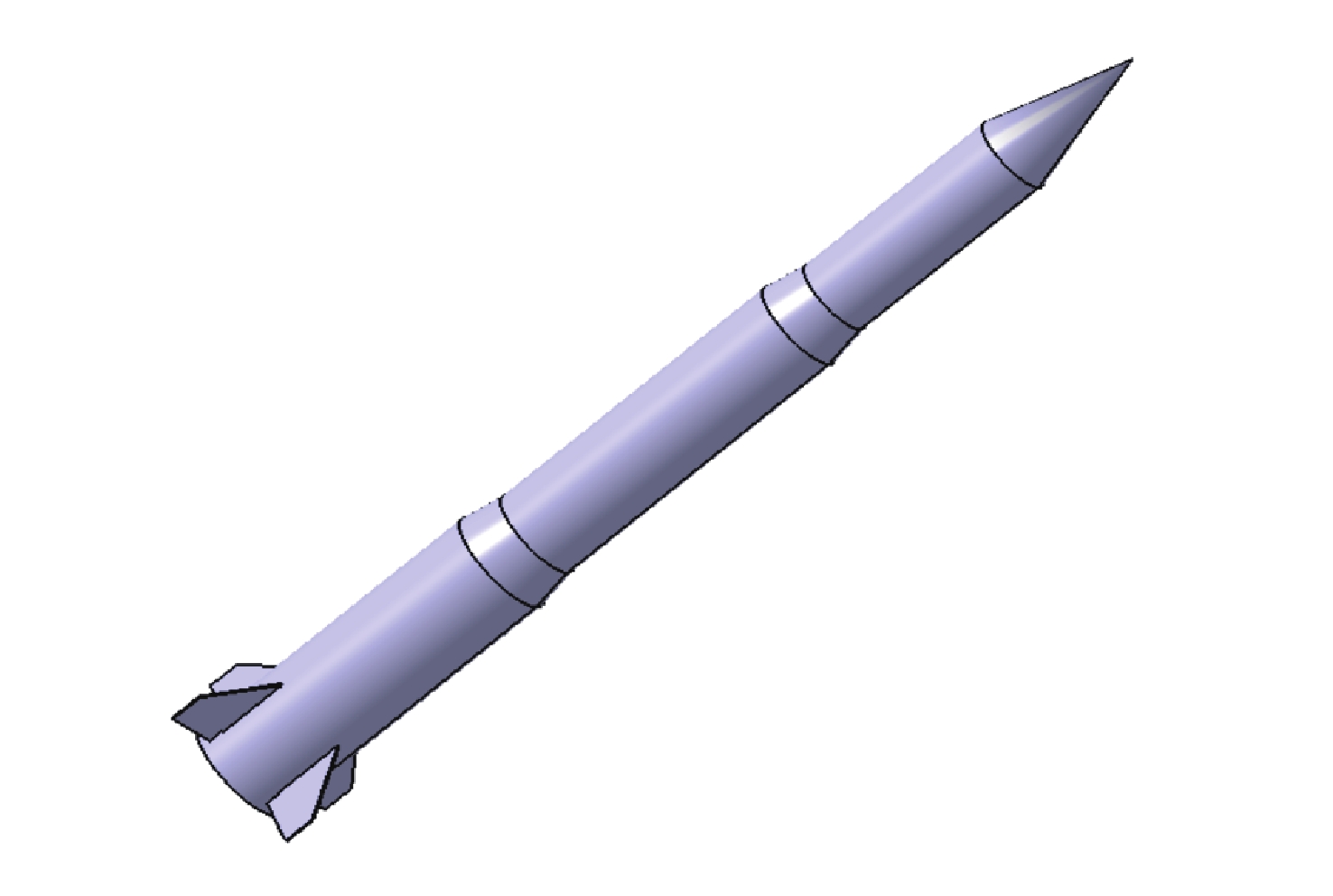
 下载:
下载:


